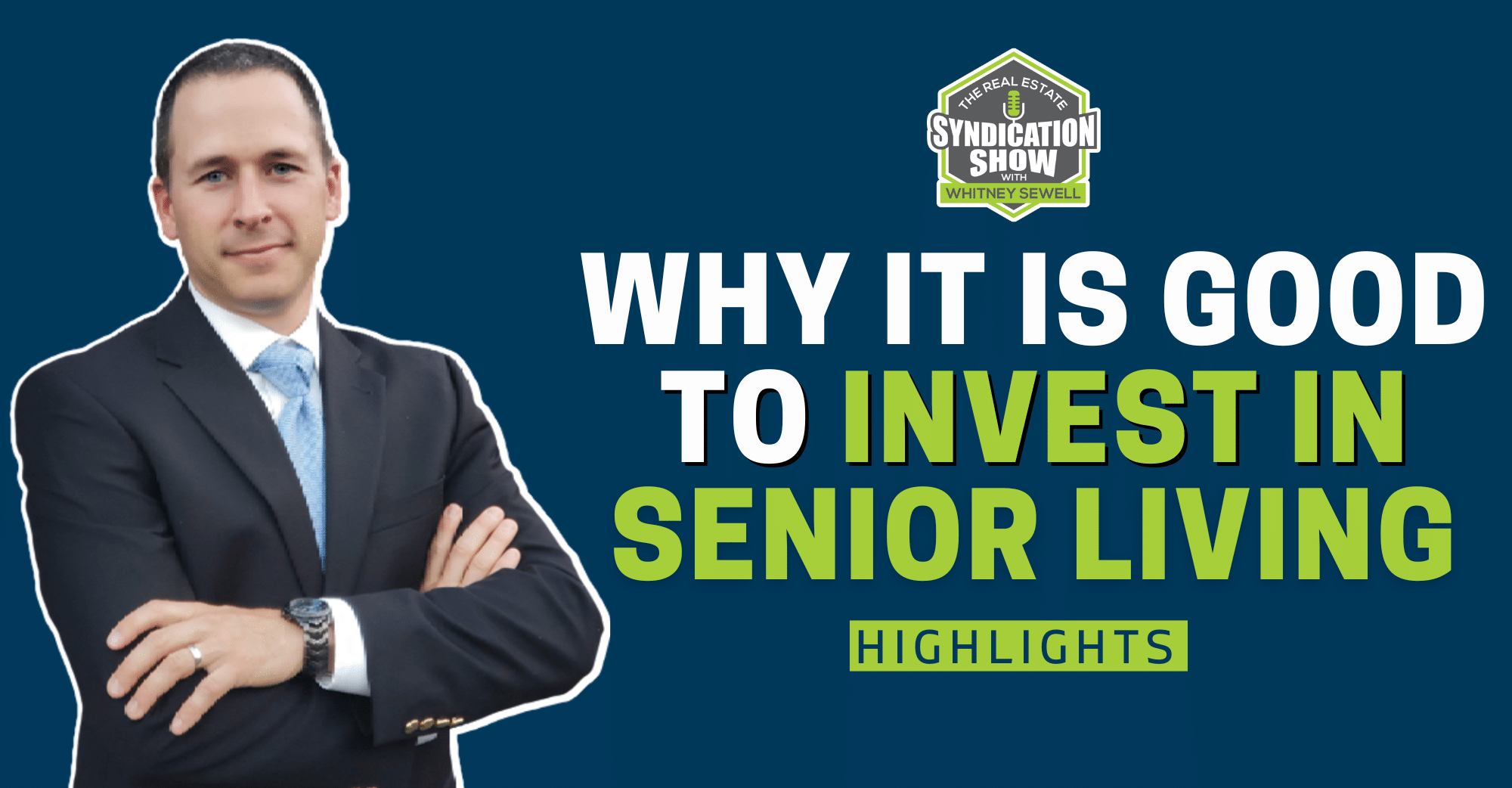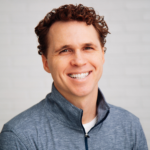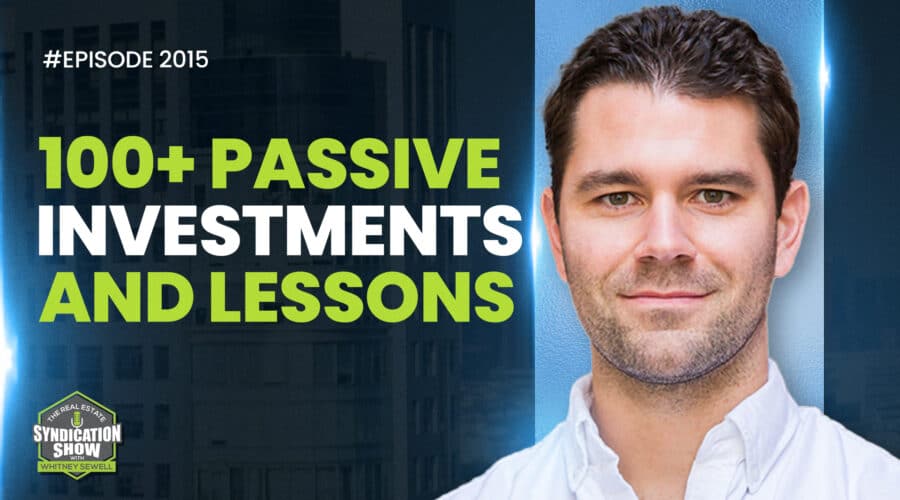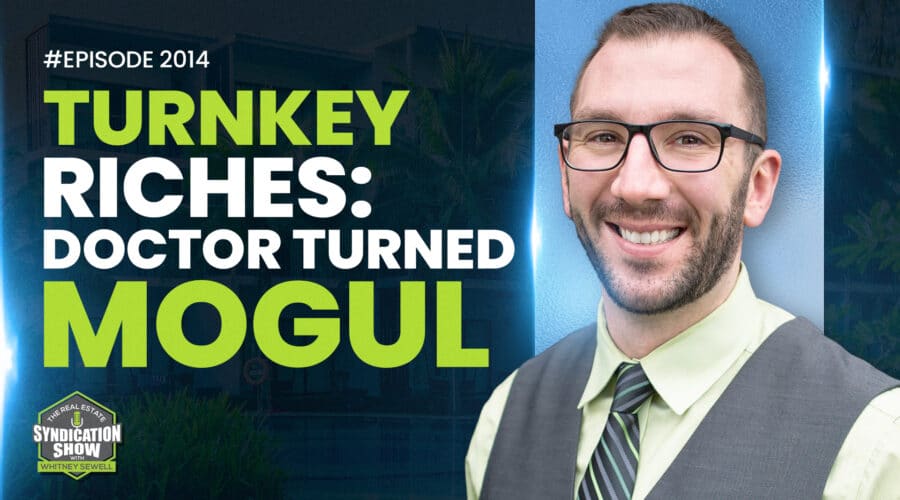Will senior living be a smart addition to your investment portfolio? In recent years, senior living has proven its market resilience throughout all economies providing a stable ROI for investors. With baby boomers aging, people living longer, and a general acceptance of the idea of assisted or independent senior living and retirement communities, senior living is poised to continue growing for years to come.
Watch the episode here:
Listen to the podcast here:
In this #Highlights episode, we look back at our conversations with Brandon Schwab and Adam Benton. Having experienced first-hand the deficient care of his grandfather at a large, industrial-type senior living facility, Brandon vowed to improve the industry by starting his own senior living company that provides better quality care to the elderly. On the other hand, Adam talks about demographic trends in senior living and the similarities between the senior living model and multifamily. Listen now to learn all the reasons why it is good to invest in senior living!
Key Points From This Episode:
- A unique senior living concept and model to start your own business.
- Differences between typical large senior living facilities and the small senior living concept.
- Why smaller senior living facilities are able to offer more care to residents than huge, industrial-type building facilities.
- Demographic trends in senior living and in real estate in general.
- How senior living is similar to multifamily.
- Reasons why senior living is a good investment.
- Staffing structure and requirements of a senior living facility.
- Staff reputation and ability to provide excellent care matter most in senior living.
Tweet This!
“If you don’t own any assets, you don’t own anything!” –Brandon Schwab
“This concept (senior living) is able to operate in all areas and it probably operates easier in towns where there aren’t tons of people.” –Brandon Schwab
“Because of that need-driven nature of the business, what we find is that in various economic conditions, there’s always demand.” –Adam Benton
“[Senior living] feels more like a cruise ship on land.” –Adam Benton
Links Mentioned in Today’s Episode:
Shepherd Premier Senior Living website
Boutique Senior Living Fund website
Call Brandon Schwab at (847) 860-6432 or (847) 380-8624
WS1348: Syndicating Senior Living Assets | Brandon Schwab
WS1374: Why Invest in Senior Housing | Adam Benton
About Brandon Schwab
The visionary behind Shepherd Premier, Brandon is on a mission to raise the bar for senior living. He founded Shepherd Premier Senior Living in 2014 with a vision to improve the senior living industry by providing a better way of delivering quality care that is resident-focused, not bottom-line-focused. Brandon saw the need for quality care. As a passionate businessman and a caring grandson, he wholeheartedly pursued the solution through the boutique senior living niche industry.
Today, Shepherd Premier has five operational homes in Northern Illinois and plans to take their senior care model coast-to-coast. As CEO, Brandon brings 20+ years of operating experience to manage real estate acquisition, development, and financing through the Boutique Senior Living Fund.
About Adam Benton
Adam loves working with seniors to help provide a “Stellar Life”. He was recognized nationally by Argentum (the leading industry association) with a “40 Under 40” award for leadership. He served for three years on the Utah Alzheimer’s Association board to advocate for seniors with dementia, raise awareness of the disease, and fund research.
He lives in Salt Lake City, UT, with his wife and five kids, four boys and a girl, all redheads, a set of identical twins, and a favorite son with Down Syndrome. He completed a bachelor’s in finance at Brigham Young University and an MBA with an emphasis in Real Estate from Columbia University. He spent five years in finance on Wall Street and co-founded Stellar Senior Living in 2011 with his family.
Full Transcript
EPISODE 1637
[INTRODUCTION]
Whitney Sewell (WS): This is your daily Real Estate Syndication Show and I’m your host, Whitney Sewell. Today we have packed a few different shows together that we call #Highlights to help you to get the most bang for your time and educate you on the topics that you want to learn from. We would love to hear from you. I am grateful that you are with us today. Have a blessed day.
[INTERVIEW 1]
WS: Brandon, tell us a little bit about your business model, who you are, and maybe why this asset class as well. Why did you pursue this asset class after you tell us how you got there?
Brandon Schwab (BS): Well, I opened up our first company when I was about 15 years old. I was doing cars and also RVs. I cleaned them for about 14 years. And then I quickly figured out at the end of the 2008 crash that if you don’t own anything that is going to own any assets, you don’t own anything. So, I quickly found out the hard way that I thought I owned something, but at the end of the day, I didn’t own anything. So, I got investing in assets in 2010. I began wholesaling the first couple of years. And then from 2010 through 2012, I wholesaled. Then, from 2012 through 2014, I figured out quickly that I needed income coming in so that I didn’t have to constantly always take care of things. So from 2012 to 2014, I built passive income of $5400 each month, and then I got exposed to a concept down in Florida of how to care for the elderly. It was totally the opposite of everything I’ve been able to get exposed to beforehand.
Back before, I was exposed to all the huge 100 to 200-type places for the elderly that typically are going to have an odor inside. I hated the atmosphere. Our family member had an experience there that was pretty bad actually. He didn’t get awesome care and I just hated the overall atmosphere. But then, down in Florida, I got exposed to what was totally different. But that’s kind of how I got into this today. It was that I discovered there was a need and it wasn’t being properly taken care of. I don’t feel that our country takes care of the elderly, as good as they ought to. I feel how they do it is actually terrible. And I feel that it can be done drastically differently. And then, as I got exposed to how it could be done totally differently, I felt that I had to go after that and take care of it. So, fast forward to today, I’ve got five homes up and operating that are between 10 beds, and I bought 20 beds per home caring for the elderly. I’ve got two opening in quarter three 2022. And I’ve got 7.2 acres of land too that I can put six homes on.
WS: Awesome. So, 2008 happened, you’re already an entrepreneur, but you learned that hey, if you don’t own any assets, you almost own nothing, right? So, if we can all just learn that early on. Wished they teach me that in high school, but they didn’t. But you started wholesaling, and then you quickly figured out, I need some passive income. It just seems like so many of us go through that transition. But, you were even successful there in building that passive income. You said, over $5000 a month which is great. I love how you were exposed to this asset class. You obviously had cared for the elderly, like you wanted to see something done differently. Unfortunately, your family member was receiving care and it was very poor. I think it’s so neat how as entrepreneurs, oftentimes, a business is created because we see an opportunity. We see something that we want changed. You did that, and you’re doing that. And so, share a little bit about your business model. I noticed, like you said, this many homes or you have 10 beds in this home. Oftentimes, when I think of senior living, or we talked about it on the show, it looks like a complex or an old hotel, or it’s something like that it’s built that way, like an apartment community. And that’s what I think when I think of senior living. But you talked about this home model with so many beds and a home. What does that mean? Talk about the differences there. Maybe why you’re going that route.
BS: A big portion of the people that are older that I take care of, they have been in their own home for 40, 50, 80 years, right? Whoever thought, at the end of that, they ought to go to this huge cold 100 to 200-type building? Chances are, it probably isn’t going to be them. If they are asked, they would prefer to be in a home that’s going to be a cozy home, that has an atmosphere that is warm. And it doesn’t have tons of people but it has enough people to keep them active. So, the experience that I had was the total opposite. I have been in the 100 to 200 that has the odor inside. It has the atmosphere where everyone’s asking you for help because I found out that the average caregiver there has to care for 20 to 30 people. And I said, no, that’s terrible. But then, I also got exposed to the opposite of it where they had a five-person house and I said, you know, a five-person house is cool if you are the owner-operator, like in there doing everything. But that isn’t really a duplicatable company because you don’t have the income to pay for anyone else to actually operate. So, I have been in each of them.
And I said, how about if we do something that’s kind of different? How about if we do something that’s like 10 to 20 people per home? But don’t ever go over that, right? Just always keep it cozy, and keep it where they feel that they are at home. I feel that that’s key. And I feel that post-Covid, Covid has actually changed the industry of how people think of it. Over the past couple of years, you have heard of people in the 100 to 200-type places that really didn’t get very good care. And I think Covid is going to be the factor that’s going to change how people think of it. And after Covid, they expect a higher quality of care and the 100 to 200-type place is just isn’t it. So, we are doing everything we can to change the industry from a very big cold-type building to a very cozy home that has 10 to 20 per home. However, that doesn’t tell you that all of us aren’t going to have 100, 200, 500, 2000 homes that add up to a huge count. We’re just doing it because I feel that how you offer care has to be the top thing. And I feel like these 100 to 200-bed buildings aren’t really built for great care. They’re built for the owners to earn tons of money.
WS: I like what you said. Keep it where they feel like they’re at home, right? And I have a grandfather who’s 101 and a grandmother, that’s 94. They still live at home, believe it or not. He’s a world war two veteran. I mean, they’ve been blessed with amazing health. But this last year or two, it’s really declined quite a bit, unfortunately. And so, we’ve been struggling with that. And they live in a part of the country where it’s like, it’s one stoplight town, there’s almost nothing there. So, it’s hard to find care for them. And so, it’s interesting to think about this model, where in that community, it’s hard to see a building, a big senior living facility. No doubt, if you had a home like you’re talking about, there’s plenty of people, seniors there that need that type of care as well. So, I could even see in different markets where this model would work where the other model may not do as well in a market like that. Have you seen things like that?
BS: Well, I can tell you, our very first home, I bought a house, it was 4880 feet on the very first floor. It was on three acres but it was in a town of 832 people. Now, if you think of that, you’d go, wow, that’s a terrible place to open. But I filled it. I kept it full at 98% occupancy for over four years. So, this concept is able to operate in all areas and it probably operates easier in towns where there aren’t tons of people, I mean, under 25,000. Perfect for us.
[INTERVIEW 2]
WS: Adam, welcome back to the show. I’m excited to have you back. You’ve accomplished a lot, you and your team. You’re in 10 states, 2500 employees, 4000 beds, and senior housing. I mean, it doesn’t happen by sitting around, letting the grass grow on your feet. By no means, did he put in a ton of work. We had a great show and we talked about many things around that asset class. You laid out many things that are so important to any entrepreneur in real estate.
Adam, why should I invest in senior housing specifically? Not you as much but just like that asset class.
AB: I’ve been in senior housing for a decade. In fact, in just about a week, we hit our 10-year mark. There are a couple of things that I, first off, you gotta remember, I look in the mirror every day “drinking the Kool-Aid”, saying this is the best industry to be in. So, I am a little biased, but I will tell you a few things related to senior housing. One, it’s a very need-driven business. As much as it’s like a combination of real estate where people are looking for great rents with really nice amenities and good locations. And then on the other half, there’s a healthcare component to it. What that means is if they’re really looking for a good team that’s going to take care of themselves or their mother or their loved one. That’s a nice blend of those two when somebody’s looking around. And because of that, that need-driven nature of the business, what we find is, is that in various economic conditions, there’s always demand. That’s probably number one.
But in terms of what I think are the three main drivers of growth in senior housing, the first is that baby boomers are aging. Baby boomers are still kind of in their 60s or 70s, our average age is 86 years old. And when you look at baby boomers, everybody thinks, okay, after World War 2, then people came home and they had a bunch of babies. And that’s baby boomers. But when you actually look at growth rates of births in the United States, it started in the late 30s, in the silent generation, 1936-1937. And that trend goes up for 20 years straight, and there’s a little blip during World War 2. That’s where they delineate between silent generation and baby boomers. So, when we look at it, if you just take 1937, which is when things started picking up (I’m doing that on my phone), so 1937 plus 86, which is our average age, that gets to 2023. So, we’re sitting here in 2022, and we believe that’s the very beginning of just a huge demographic growth. So, that’s one, baby boomers are aging.
The second is just people living longer meaning somebody that was over 100 years old, 10, 15, even 20 years ago is just like an amazing thing. Of our 30 locations, you can find at least a handful people over 100, just every day, just that at the property. So, people are living longer. And then the last one is just the acceptance of senior housing, assisted living, independent living, memory care. You know, 20 years ago, it was maybe 8% of the population above 75 years old uses assisted living. Now, currently in the country, it’s 13.5% that’s continued to grow. In places where it’s been around longer like Portland or Seattle, it’s more like 20%. That’s actually the largest growth factor. So, to button it up, baby boomers are aging, people living longer, larger utilization or penetration rate related to senior housing. And that trend is a 20-year growth trend and we believe it starts in about now. That’s the gist of it.
WS: Yeah, that’s incredible information. And I don’t know that I’ve heard many of those things laid out that way. I have a grandfather that’s 101, grandmother, 94. They still live at home, believe it or not. Though, we’ve had to work through some of that, or my mother is working through all that. But you know, I was thinking through this, and we don’t have a ton of time to spend on this, but I just wanted to hear because you mentioned the health care part of it, I just wondered, because I don’t know this business, but is the health care providers or that part of your business, which is so important, I mean, the care of these individuals is like your bread and butter, I would think, right? You want them to stay. You want the families to be happy and all that. And so, are those people on your staff? The healthcare portion? Are they employed by you? Or is that a third party? How does that work?
AB: That’s a great question. So, the answer is yes. The 2400 employees that we have today, that includes everything from the general manager, in our case, it’s called executive director, salespeople, business office manager, you have maintenance guys, a lot of that is similar to what you might see in a multifamily project. And then you layer on like a chef, sous chefs, servers, dishwashers, that’s your dining room. And then you have like a few nurses like RNs and LPNs. And then they have med techs and CNAs that help care for folks. And they have activities, people that that actually run activities, do transportation. Those are all people on our staff that truly make a difference. We say that chandeliers don’t give care, people do. So, there’s a big component to the fact that even though the building is important, unlike multifamily, where it’s incredibly important, the more important thing or equally important is also just the reputation of your staff and their ability to actually properly care for the people that live in our locations.
Now, we are private pay which means that people are usually moving out of their homes into assisted living where they get more of the services or independent living and it’s more personal care. So, we’re not doing anything like IVs or trachea or feeding tubes, none of that stuff. It’s really just grooming, bathing, maybe help with escorting, things like that, that are more personal care, not necessarily medical related. I think that’s a key component. You think about the average length of stay of our residents which is two and a half to three years and the types of care that they need. When people think of senior housing, they think of skilled nursing, kind of step away from a hospital, maybe not smells good and it’s not the most exciting place to be. That’s really not the case in senior housing today. It feels more like a cruise ship on land, that’s a good way to think about it.
[END OF INTERVIEW]
[OUTRO]
Whitney Sewell: Thank you for being with us again today. I hope that you have learned a lot from the show. Don’t forget to like and subscribe. I hope you’re telling your friends about The Real Estate Syndication Show and how they can also build wealth in real estate. You can also go to LifeBridgeCapital.com and start investing today.
[END]
Love the show? Subscribe, rate, review, and share!
Join the Real Estate Syndication Show Community:






